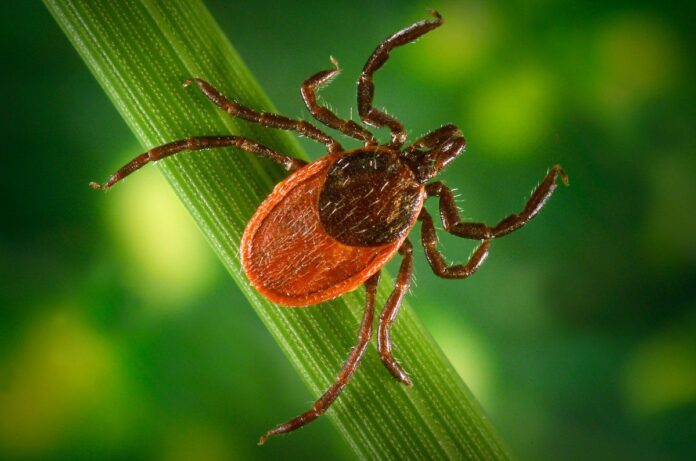COLUMBUS — With the great outdoors being a popular destination during the pandemic, it’s important to watch out for another potential threat you might not easily see: ticks. Be on the lookout for them through late fall.
The warmest months are the most common times these tiny, blood-sucking bugs pass on diseases.
Risa Pesapane, an assistant professor with the colleges of Food, Agricultural, and Environmental Sciences (CFAES) and Veterinary Medicine at The Ohio State University, researches ticks in Ohio. She actually thrives on going through tick-infested areas and collecting ticks, even off of deer shot by hunters.
Four main ticks
In January, Pesapane launched a study tracking the frequency of ticks on Ohio deer, and another on stray dogs. Pesapane discussed tips on how to avoid tick bites as well as the risks associated with each of the four main ticks found in Ohio.
Among all ticks in Ohio, the biggest threat comes from the blacklegged tick, also called the deer tick. A bite from that tick could transmit anaplasmosis, a disease that causes fever and body aches, or the more serious Lyme disease.
Lyme disease has been on the rise in Ohio over the past decade. Left untreated, a person with the disease can develop various symptoms including numb or weak limbs and inflamed membranes surrounding the brain, also known as meningitis.
The other three ticks most common in Ohio are the lone star tick–that one can cause a person who is bit to develop an allergy to red meat, and can also transmit ehrlichiosis, which causes flu-like symptoms; the American dog tick, also called the wood tick, which can cause Rocky Mountain spotted fever; and the Asian longhorned tick, which can be fatal to cattle.
Those four ticks are the ones to watch out for the most in Ohio.
Asian longhorned tick
So far in the United States, the Asian longhorned tick has not been shown to carry bacteria or viruses that can cause diseases in people. But we know internationally that Asian longhorned ticks do transmit human diseases. It might just be a matter of time before they pass on diseases to people in this country.
The Asian longhorned tick has killed cattle in the United States. The ticks can swarm a cow and drain a lot of blood, or they can transmit various diseases. The Asian longhorned tick is the newest tick in Ohio and in this country.
In May, a stray dog was bitten by an Asian longhorned tick in Gallia County in southern Ohio. This tick is being watched closely because it can multiply quickly. A female Asian longhorned tick can reproduce on its own without a male, laying a couple thousand eggs at once.
Protect yourself
If someone loves the outdoors, how do they keep from being bitten? It’s easy to take steps to prevent a tick bite.
It’s as simple as changing the clothing you’re wearing. Wear long sleeves and pants. Tuck your pants into long socks. “Tick fashion,” we call it.
Most of the time, good clothing and a good tick check is all you need to limit the ticks on you. But you could put on repellent, too.
How can ticks feed on a person for days without being noticed? Ticks can be tough to see because they can be tiny, such as the Asian longhorned tick, which typically ranges in size from a poppy seed to a sesame seed, depending on which stage of growth it’s in and whether it has been feeding.
Besides being small, ticks often go unnoticed because you might not feel when they bite. Tick saliva is well-evolved. It contains substances that help the tick feed off of you: analgesics, which are numbing, and also agents that stop clotting so that the ticks can easily suck out blood.
As a result, ticks can stay on their hosts for days, up to a week. They can go undetected for a long period of time.
The good news is most of the germs that ticks can pass on are not immediately transmitted. The pathogens have to move from the tick’s gut to its saliva before it can pass on those pathogens. So, if you remove the tick within the first 24 to 48 hours, there’s a good chance you or your animal won’t get a disease.
Tick bite
Definitely don’t touch the tick with your bare hands or apply any liquids to it to try to kill it. Use tweezers, ideally flat-tipped tweezers, or a tick removal tool, to grasp the tick as close to your skin as possible. Use steady pressure to pull it straight out.
If the mouthparts of the tick are left in the skin, don’t try to dig them out. That could lead to a secondary bacterial infection.
Mark the calendar when you got bit and monitor yourself for any signs of illness. Contact a health care provider, if necessary.
For more information on ticks, u.osu.edu/bite/. If you’d like to help with research on Ohio ticks, please send ticks you find to go.osu.edu/sendticks.











Nice article BUT…Why not include pictures of the different ticks described…That would have bee very helpful !
Patricia, I wrote an article about identifying the various disease-carrying ticks in Ohio a few years ago. Check it out, it may contain the information you’re looking for – https://www.farmanddairy.com/top-stories/how-to-identify-disease-carrying-ticks-in-ohio/426320.html